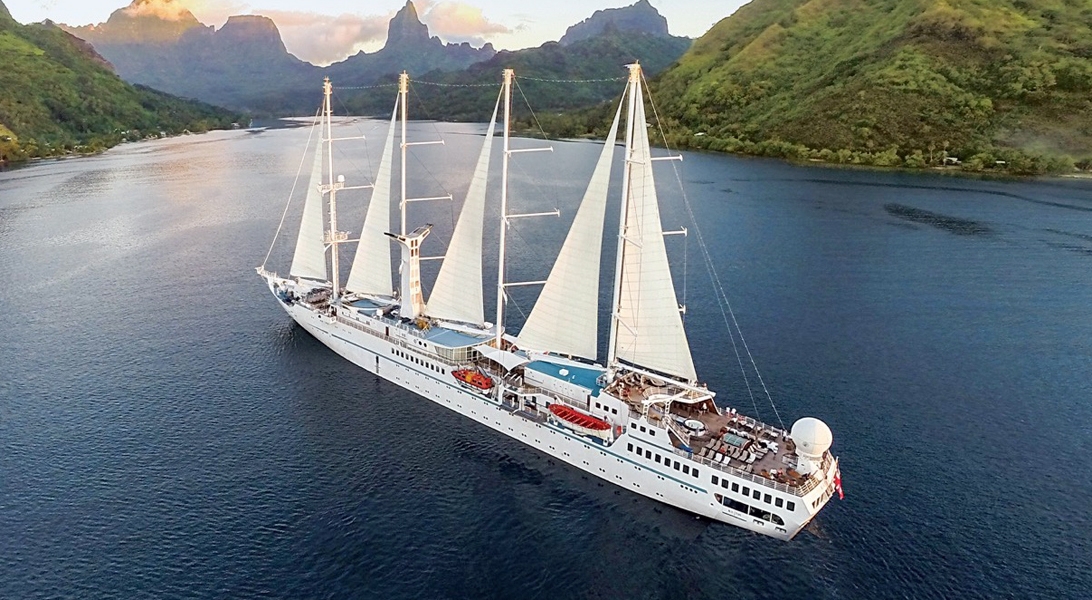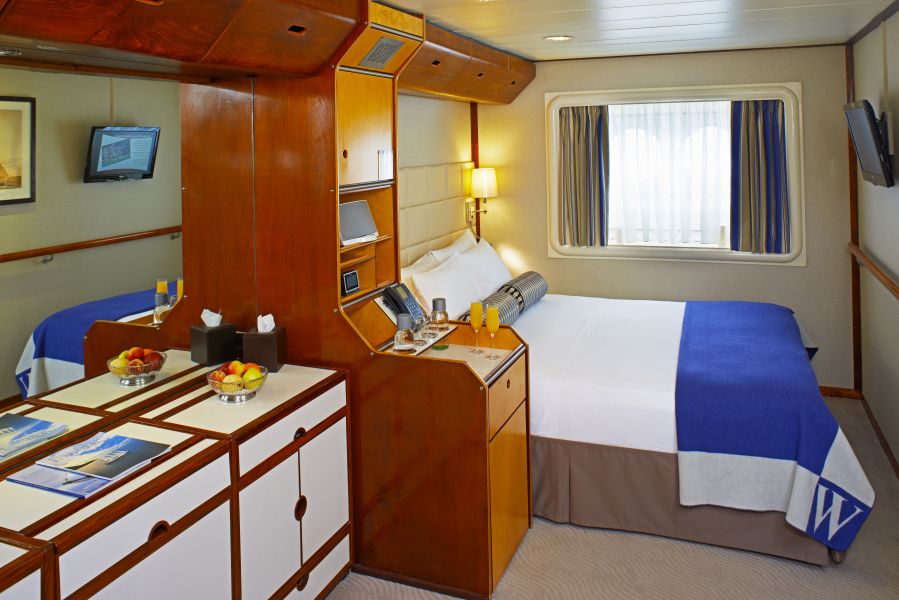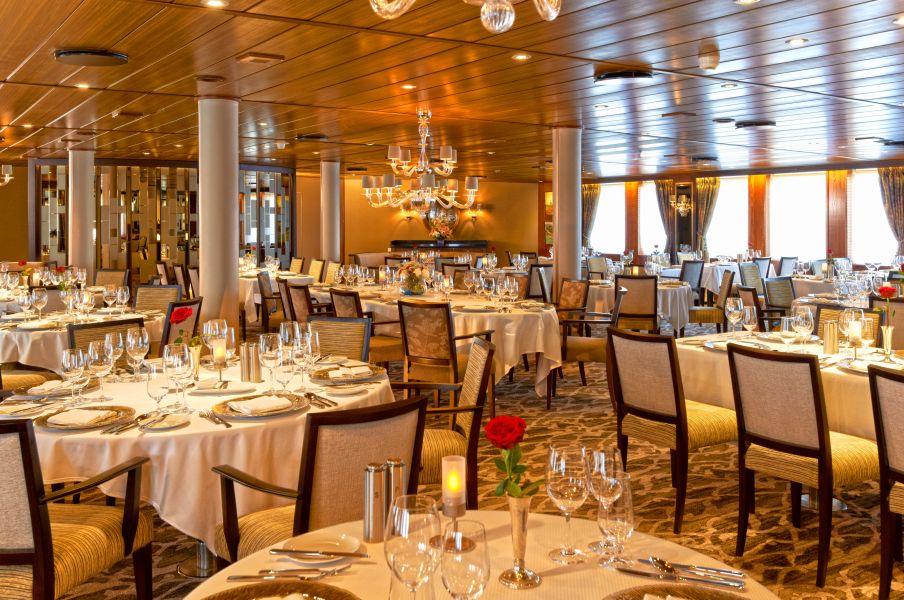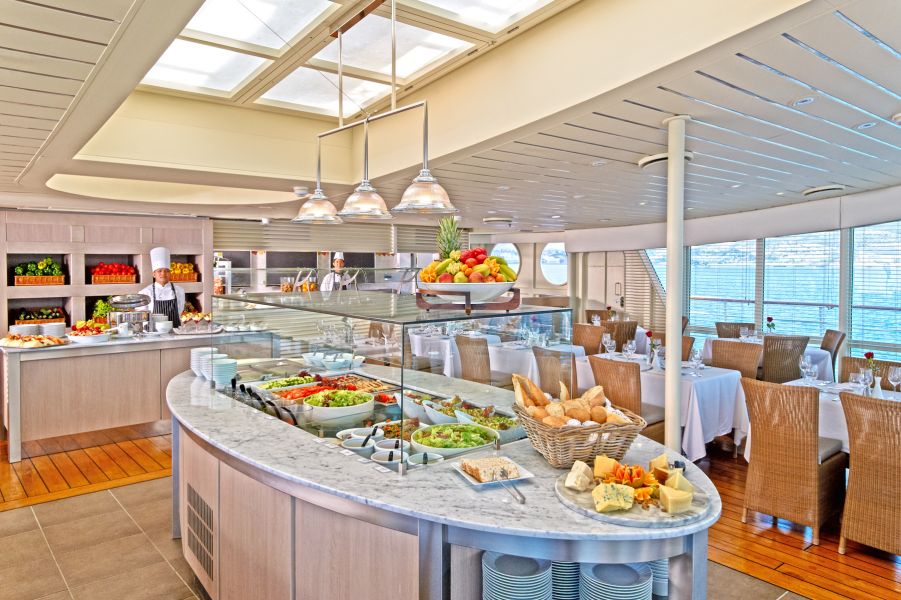This site uses cookies as defined in our Cookie Policy, by continuing to use this site you agree to their use.
Continue
| Arrive | Depart | ||||||
| 8th08 | AprApr | 202727 | Venice, Italy, embark on the Wind Spirit | 17:00 | |||
Venice is a city unlike any other. No matter how often you've seen it in photos and films, the real thing is more dreamlike than you could imagine. With canals where streets should be, water shimmers everywhere. The fabulous palaces and churches reflect centuries of history in what was a wealthy trading center between Europe and the Orient. Getting lost in the narrow alleyways is a quintessential part of exploring Venice, but at some point you'll almost surely end up in Piazza San Marco, where tourists and locals congregate for a coffee or an aperitif. No other sea approach in the Adriatic raises goose bumps like Venice, a small ship exclusive where the entire city and its lagoon are a UNESCO World Heritage Site. On your luxurious home-away-from home, you arrive already equipped with a sense of what it's like to live in the city that's neither land nor water. Add your own sigh to the Bridge of Sighs, sip a spritz al bitter as you plot your agenda, and let the water taxis do your navigating unless you don't mind getting lost. Not such a bad prospect, with serendipitous discoveries around every corner. | |||||||
| 9th09 | AprApr | 202727 | Trieste, Italy | 08:00 | 18:00 | ||
Up until the end of World War I, Trieste was the only port of the vast Austro-Hungarian Empire and therefore a major industrial and financial center. In the early years of the 20th century, Trieste and its surroundings also became famous by their association with some of the most important names of Italian literature, such as Italo Svevo, and English and German letters. James Joyce drew inspiration from the city's multiethnic population, and Rainer Maria Rilke was inspired by the seacoast west of the city. Although it has lost its importance as a port and a center of finance, it has never fully lost its roll as an intellectual center. The streets hold a mix of monumental, neoclassical, and art-nouveau architecture built by the Austrians during Trieste's days of glory, granting an air of melancholy stateliness to a city that lives as much in the past as the present. Trieste, Italy, is a fascinating crossroads where Italian, Slavic, and Austrian influences meet. Overlooking the Adriatic, it charms with grand Habsburg architecture, the bustling Piazza Unità d'Italia, and the historic Caffè San Marco. Stroll the elegant waterfront, visit Miramare Castle's cliffside gardens, and savor the city's famous coffee culture and fresh seafood. | |||||||
| 10th10 | AprApr | 202727 | Ravenna, Italy | 08:00 | 17:00 | ||
A small, quiet, well-heeled city, Ravenna has brick palaces, cobblestone streets, magnificent monuments, and spectacular Byzantine mosaics. The high point in its civic history occurred in the 5th century, when Pope Honorious moved his court here from Rome. Gothic kings Odoacer and Theodoric ruled the city until it was conquered by the Byzantines in AD 540. Ravenna later fell under the sway of Venice, and then, inevitably, the Papal States.Because Ravenna spent much of its past looking east, its greatest art treasures show that Byzantine influence. Churches and tombs with the most unassuming exteriors contain within them walls covered with sumptuous mosaics. These beautifully preserved Byzantine mosaics put great emphasis on nature, which you can see in the delicate rendering of sky, earth, and animals. Outside Ravenna, the town of Classe hides even more mosaic gems. Ravenna is connected to the Adriatic Sea by the Candiano Canal. It is known for its colorful mosaics adorning many of its building. There are many well-preserved late Roman and Byzantine structures with eight buildings comprising the Early Christian Monuments of Ravenna, a UNESCO World Heritage Site. | |||||||
| 11th11 | AprApr | 202727 | Opatija, Croatia | 08:00 | 16:00 | ||
Stroll along Opatija’s seaside promenade, and soak up the splendour, as you enjoy fresh sea air, the sight of waving yacht masts, and the presence of grand ocean-facing buildings. Historically a fashionable destination for European aristocracy, the city is just as in-demand today - with palatial structures watching out over an inviting blue sea, and a border of lush green mountains stretching around the city. Vibrant gardens, glorious weather and endless seafront combine to ensure that Croatia’s original tourist destination remains one of the country’s finest. Once a favorite of Austro-Hungarian royalty, small ship exclusive Opatija is known for its 19th-century villas, palm-lined Lungomare promenade, and peaceful beaches. Relax in this elegant resort town filled with history, charm, and coastal views. | |||||||
| 12th12 | AprApr | 202727 | Sibenik, Croatia | 10:00 | 17:00 | ||
Šibenik's main monument, its Gothic-Renaissance cathedral, built of pale-gray Dalmatian stone and designated a UNESCO World Heritage Site, stands on a raised piazza close to the seafront promenade. From here a network of narrow, cobbled streets leads through the medieval quarter of tightly packed, terra-cotta–roof houses, and up to the ruins of a 16th-century hilltop fortress. The city has never been a real tourist destination. Before the Croatian war for independence, it was a relatively prosperous industrial center, but when the factories closed, Šibenik sank into an economic depression. However, the cathedral more than warrants a look, and it makes a decent base for visiting the waterfalls of Krka National Park. One of Croatia's oldest coastal cities and a small ship exclusive, Šibenik offers a perfect blend of medieval history and seaside beauty. Stroll through stone streets to discover St. James Cathedral, quaint cafes, and views of the Dalmatian coastline. | |||||||
| 13th13 | AprApr | 202727 | Dubrovnik, Croatia | 09:00 | 23:00 | ||
Nothing can prepare you for your first sight of Dubrovnik. Lying 216 km (135 miles) southeast of Split and commanding a jaw-dropping coastal location, it is one of the world's most beautiful fortified cities. Its massive stone ramparts and fortress towers curve around a tiny harbor, enclosing graduated ridges of sun-bleached orange-tiled roofs, copper domes, and elegant bell towers. Your imagination will run wild picturing what it looked like seven centuries ago when the walls were built, without any suburbs or highways around it, just this magnificent stone city rising out of the sea.In the 7th century AD, residents of the Roman city Epidaurum (now Cavtat) fled the Avars and Slavs of the north and founded a new settlement on a small rocky island, which they named Laus, and later Ragusa. On the mainland hillside opposite the island, the Slav settlement called Dubrovnik grew up. In the 12th century the narrow channel separating the two settlements was filled in (now the main street through the Old Town, called Stradun), and Ragusa and Dubrovnik became one. The city was surrounded by defensive walls during the 13th century, and these were reinforced with towers and bastions in the late 15th century.From 1358 to 1808 the city thrived as a powerful and remarkably sophisticated independent republic, reaching its golden age during the 16th century. In 1667 many of its splendid Gothic and Renaissance buildings were destroyed by an earthquake. The defensive walls survived the disaster, and the city was rebuilt in baroque style.Dubrovnik lost its independence to Napoléon in 1808, and in 1815 passed to Austria-Hungary. During the 20th century, as part of Yugoslavia, the city became a popular tourist destination, and in 1979 it was listed as a UNESCO World Heritage Site. During the war for independence, it came under heavy siege. Thanks to careful restoration, few traces of damage remain; however, there are maps inside the Pile and Ploče Gates illustrating the points around the city where damage was done. It’s only when you experience Dubrovnik yourself that you can understand what a treasure the world nearly lost While larger ships must pass by, we anchor right beyond the famous walled city so you can admire its beauty with every glance. Tender ashore and step right into Old Town, a UNESCO site where no cars are allowed, just eons of history. Capture the exhilarating views on your camera — and in your memory. End your day at the Buza Café (if you can find it) watching bold divers leap off the cliffs into the crystalline sea. | |||||||
| 14th14 | AprApr | 202727 | At Sea | ||||
| 15th15 | AprApr | 202727 | Piran, Slovenia | 09:00 | 22:00 | ||
| Situated on a tiny piece of land jutting into the sea and considered to be the most beautiful of Slovenia's coastal towns, Piran is full of medieval architecture, narrow streets, and compact houses. A walk to the beautiful oval-shaped main square will greet you with a statue of Giuseppe Tartini, composer and virtuoso violinist, and the most famous man of Piran. Around the square are attractions like Venetian House, and a delightful Gothic-Venetian structure, The Sergei Masera Maritime Museum and the Church of St. George with its gorgeous view over the city and the harbor from the bell tower. Take a tour to the nearby Skocjan Caves National Park, a UNESCO site. | |||||||
| 16th16 | AprApr | 202727 | Venice, Italy, disembark the Wind Spirit | 08:00 | |||
Venice is a city unlike any other. No matter how often you've seen it in photos and films, the real thing is more dreamlike than you could imagine. With canals where streets should be, water shimmers everywhere. The fabulous palaces and churches reflect centuries of history in what was a wealthy trading center between Europe and the Orient. Getting lost in the narrow alleyways is a quintessential part of exploring Venice, but at some point you'll almost surely end up in Piazza San Marco, where tourists and locals congregate for a coffee or an aperitif. No other sea approach in the Adriatic raises goose bumps like Venice, a small ship exclusive where the entire city and its lagoon are a UNESCO World Heritage Site. On your luxurious home-away-from home, you arrive already equipped with a sense of what it's like to live in the city that's neither land nor water. Add your own sigh to the Bridge of Sighs, sip a spritz al bitter as you plot your agenda, and let the water taxis do your navigating unless you don't mind getting lost. Not such a bad prospect, with serendipitous discoveries around every corner. | |||||||






The images shown are for illustration purposes only and may not be an exact representation of what you find on the ship.

| Grade Code | From | To | |
| B | Category B | £2,860 | £2,860 |
| BX | Category BX Deluxe | £3,121 | £3,121 |
| A | Category A | £3,382 | £3,382 |
| AX | Category AX Deluxe | £3,531 | £3,531 |
Every inch of your stateroom is designed for comfort. Luxurious Egyptian cotton linens wrap you in pleasant sleepiness as you stretch out in your queen bed (can be separated into twins if you prefer). Your spacious bath features granite counter tops, ample storage, and a roomy shower with massage shower head. L’Occitane® bath products invite you to indulge, while comfy waffle-weave robe and slippers entice you to relax. You’ll find fresh fruit and flowers always waiting for you after a day of sun or sightseeing. And, of course, everything else you need and expect — flat-screen television and DVD, private safe. And always at your fingertips, anything you wish from room service.
The images shown are for illustration purposes only and may not be an exact representation of what you find on the ship.

Here, the dining room manager seats you, but where is your decision. There are no pre-assigned tables or first or second seatings. When you dine and with whom are entirely up to you. Seating usually begins at 6:30 p.m. and will be printed in the ship's daily program. Each delightful dish is prepared exactly to your liking – an exquisite dinner served course-by-course with a fine selection of vintage wines.

It's breakfast alfresco, full service or buffet-style, anytime till 9:30 a.m. No need to hurry. Again, the choices are many in Veranda. Choose the sumptuous, seemingly endless buffet. Or, order from the lunch menu between noon and 2:30 p.m.
The images shown are for illustration purposes only and may not be an exact representation of what you find on the ship.

Onboard entertainment facilities include: Sun Deck, Library, Casino, and The Lounge.
The images shown are for illustration purposes only and may not be an exact representation of what you find on the ship.
The images shown are for illustration purposes only and may not be an exact representation of what you find on the ship.
| 8 nights aboard the Wind Spirit | |||
| Port Taxes and Fees | |||
 | ABTA and ATOL Protection* | ||
Date 8th Apr 2027 |
Nts 8 |
Oceanview £2,860pp |
Suite £5,472pp |
Date 8th Apr 2027 |
Nts 8 |
Oceanview £2,860pp |
Suite £5,472pp |
| Oceanview staterooms from | £2,860pp | ||
| AX | Category AX Deluxe | £3,531pp | |
| B | Category B | £2,860pp | |
| BX | Category BX Deluxe | £3,121pp | |
| A | Category A | £3,382pp | |
| Suite staterooms from | £5,472pp | ||
| OW | Owner's Suite | £5,472pp | |
| Oceanview | Suite | |
| (All prices are £GBP per person) | ||
| Fri 16th Apr 202716 Apr 27 | 2,860 | 5,472 |
| Sat 24th Apr 202724 Apr 27 | 2,860 | 5,472 |
Fusion Cruises when selling travel arrangements is a trading name of The Midcounties Co-operative Ltd. Fusion Cruises is an Accredited Body Member of Midcounties Co-operative Travel Consortium. (ABTA:P6652, ATOL:6053).
Book with Confidence. We are a Member of ABTA which means you have the benefit of ABTA’s assistance and Code of Conduct.
Some of the flights and flight-inclusive holidays on this website are financially protected by the ATOL scheme but ATOL protection does not apply to all holiday and travel services offered on this website. This website will provide you with information on the protection that applies in the case of each holiday and travel service offered before you make your booking. If you do not receive an ATOL Certificate then the booking will not be ATOL protected. If you do receive an ATOL Certificate but all parts of your trip are not listed on it, those parts will not be ATOL protected. Please see our booking conditions for information, or for more information about financial protection and the ATOL Certificate go to: www.caa.co.uk
